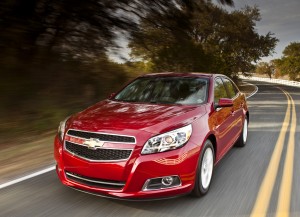
After a slight spring decline, sales of high-mileage models like the Chevrolet Malibu Eco seem to be regaining momentum.
There seems to be an almost direct correlation between fuel prices and fuel economy, at least in terms of the mileage of the vehicle the average American motorist has been purchasing this year. And with fuel prices once again starting to rise after unexpectedly tumbling for several months that means fuel economy is heading up, as well.
After a three-month drop, fuel economy of all new vehicles sold in the United States leveled off in July, according researchers at the University of Michigan Transportation Research Institute. Mileage hit an all-time record in April as U.S. fuel prices started racing towards record levels, as well.
For July, unadjusted Corporate Average Fuel Economy, or CAFE, performance was 29 mpg, the same as in June and an increase of 17%, or 4.3 miles per gallon, since October 2007.
Meanwhile, the adjusted average fuel economy – what consumers see on the Munroney window-sticker on their new cars, light trucks, minivans and sport-utility vehicles was also unchanged from June to July after a three-month decline. The combined City/Highway number came in at 23.6 mpg, also a 17%, or 3.5 miles per gallon increase from October 2007. That was the first month of monitoring by UMTRI researchers Michael Sivak and Brandon Schoettle.
The question is whether fuel economy is now heading back up again, as some other signs suggest.
In addition to average fuel economy, Sivak and Schoettle issued their monthly update of their national Eco-Driving Index, which estimates the average monthly emissions generated by an individual U.S. driver. The EDI takes into account both vehicle fuel economy and distance driven—the latter relying on data, the lower the value the better, that are published with a two-month lag.
During May, the EDI stood at 0.82, up from 0.81 in April. Overall, the index currently shows that emissions of greenhouse gases per driver of newly purchased vehicles are down 18%, overall, since October 2007.
The ups-and-downs of the fuel economy numbers appear to suggest a certain fickleness in the American consumer’s concerns about fuel prices. But there may be other factors at work, industry analysts caution. Demand for full-size pickups and other large vehicles used by construction crews and contractors has also been riding a roller-coaster this year reflecting the uncertainty of the economy.
Strong sales of those vehicles invariably bring down mileage numbers. So, with the economy showing signs of weakening in recent weeks that could mean better mileage numbers even if fuel prices stay relatively stable.
